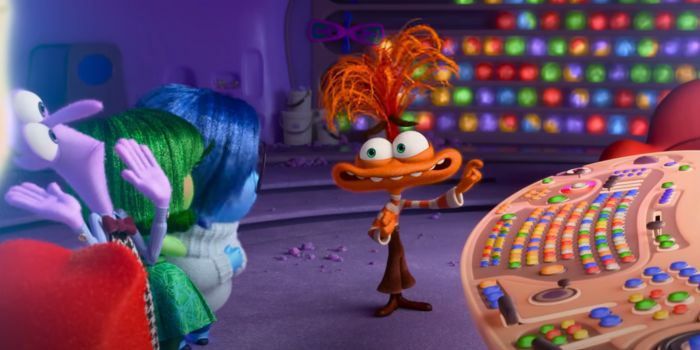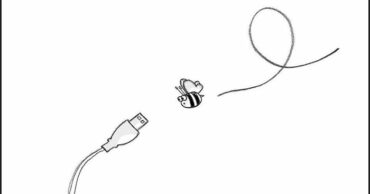A movie so relatable, that you’d be surprised when it hits your tear ducts with a powerful left hook. Inside Out 2, the highly anticipated sequel to the critically acclaimed Pixar film Inside Out, finally graced the big screen on June 10, 2024. In an era where mental health has gradually taken center stage, and therapy is no longer considered taboo, this film is a must-watch for teenagers and adults alike. Inside Out 2 is a sincere take on the critical transition of one’s mind during puberty. Ahh…puberty — a deeply sweaty and profoundly awkward phase in life where self-doubt replaces optimism, clear skin unexpectedly sprouts zits, and Mickey Mouse is unapologetically replaced by the drop-dead gorgeous Louis Partridge.
Produced by Pixar Animation Studios, Inside Out 2 is Kelsey Mann’s feature directorial debut. The film takes viewers through 13-year-old Riley’s (Kensington Tallman) tumultuous mental distress as she deals with the initial hit of puberty and the chaos that ensues in her mind with the arrival of new emotions — Anxiety (Maya Hawke), Envy (Ayo Edebiri), Ennui (Adèle Exarchopoulos) and Embarrassment (Paul Walter Hauser). The film explores nuanced themes pertaining to one’s mind, which include suppressed emotions, anxiety attacks, and finding a sense of self. A prevalent power struggle exists between pre-existing and new emotions, leading to chaotic mumbo jumbo. Let’s look at how Inside Out 2 splendidly portrays the intricacies of the mind! Spoilers Ahead!
The Introduction of New Emotions Is Hilariously Entertaining
Right off the bat, it was fun to see the new emotions enter Riley’s mind when things were apparently smooth sailing and zen. Inside Out 2 introduces new emotions most chaotically — with a boulder crashing into headquarters as it goes through renovation to accommodate these new changes. As usual, Joy’s (Amy Poehler) position as the dominant emotion is threatened by the latest arrivals, especially Anxiety.
Envy is the cutest little button with the most adorable beady eyes, and Embarrassment is just a big fella who needs a big squish. The nonchalant Ennui was the most endearing, with the wireless controller being a nice touch. The puberty alarm ringing accurately represents how puberty often comes completely unannounced and throws the mind off-balance.
Joy’s Tumultuous Journey Evokes Introspection
View this post on Instagram
The screenplay kicks off with Joy running things smoothly in Riley’s mind, with her sense of self predominantly comprised of happy memories. There’s a detail where ‘bad memories’ are catapulted to the back of the mind, which seems like a good idea at the time but eventually backfires as the story progresses. While the early years of life are filled with happiness, the film highlights how, as one grows up, the mind needs to adapt to change and be capable of feeling more sophisticated and complex emotions. Anxiety is portrayed as a vital emotion that contrasts with Joy, representing how being joyful in stressful teenage situations doesn’t always work out.
There are times when Joy is on the verge of giving up, mentioning how, as one grows older, they may not feel joy anymore — a moment that will tug on your heartstrings. The seesaw between Joy and Anxiety is the highlight of the movie, and it shows how a healthy balance can be achieved to keep things sound in Riley’s mind. The representation of Joy throughout the film serves as a welcome reminder to older audiences to search for happiness from time to time, even if life is proving to be particularly distressing at the moment.
The Depiction of Anxiety Is Frustrating but True

The introduction of Anxiety as an emotion was a stroke of genius! It was infuriating for viewers to watch Riley being pushed beyond her limits, acting out of character, and making questionable decisions. Each time Anxiety makes a decision, you feel a sudden urge to want to jump inside the screen and hug Riley. At the same time, as the screenplay progresses, a sudden wave of self-realization hits the viewers tenfold, as they are forced to reflect upon the dealings of their own minds.
Anxiety is showcased as an impulsive emotion that acts in a frenzy, which represents how teenagers often deal with it during the initial stages of puberty. It takes a significant amount of trial and error, along with the support of the other emotions, to navigate anxiety, which is translated beautifully during the emotional climax. The line from Anxiety, “I didn’t mean to hurt her! I was just trying to protect her!” represents how anxiety is a nuanced emotion that is intended to motivate and plan, and can be functional in moderate doses but turns dysfunctional when given total control.
Arguably the most relatable, powerful, and anxiety-inducing scene in the whole film is the portrayal of Riley having an anxiety attack. Viewers who’ve experienced anxiety attacks felt the scene hit too close to home with its accurate representation — especially the moment when she gets tunnel-visioned with everything spinning around her. It was heart-warming when Riley called out for Joy while she recovered from her anxiety attack, representing her internal growth.
Inside Out 2 Is a Wake-up Call on the Importance of Mental Well-being
🥳#InsideOut2 is a global phenomenon and now the #1 movie in the world! 🥳
Don’t miss it on the big screen and get tickets now! https://t.co/PIG2nAHCVc pic.twitter.com/cfubXyzqTz
— Pixar (@Pixar) June 15, 2024
Riley’s sense of self goes from just being “I’m a good person” to an array of emotions like jealousy, self-doubt, fear, and so much more — a reflection of humans being multifaceted individuals. The film showcases that one’s personality has layers that cannot be dominated by one, single emotion. It depicts how dealing with this sudden change and the initial transition can have profound effects on one’s mental health, and why learning to navigate these emotions is of utmost importance. The climax, where all nine emotions come together to hug Riley’s belief system, is exceptionally moving and sure to leave viewers bawling their eyes out.
Every single viewer can relate to the portrayal of the power struggle between emotions and the significance of striving for mental well-being. The film’s emphasis on each emotion’s positive aspects is infinitely endearing, as it reinforces the idea that toxic positivity is in no way, the aspiration. The collision of negative and positive beliefs was a powerful moment that prompted introspection. As the movie concluded, Riley’s sense of self could hold the paradox of multiple identities — possibly the greatest takeaway from Inside Out 2. Also, check out other noteworthy and extraordinary sequels from Pixar Studio!
 Follow Us
Follow Us





